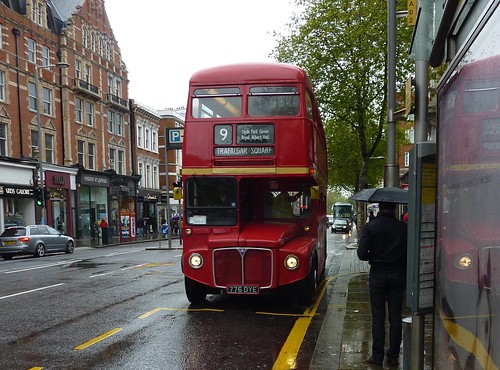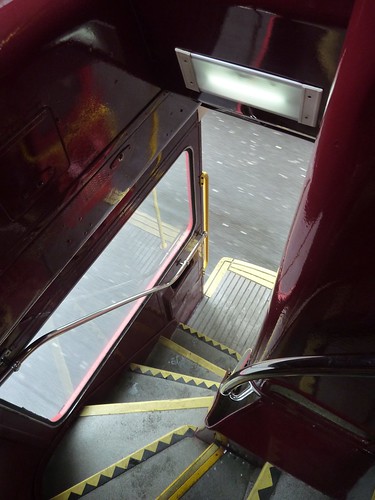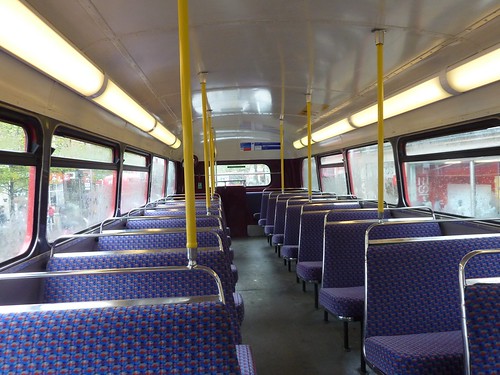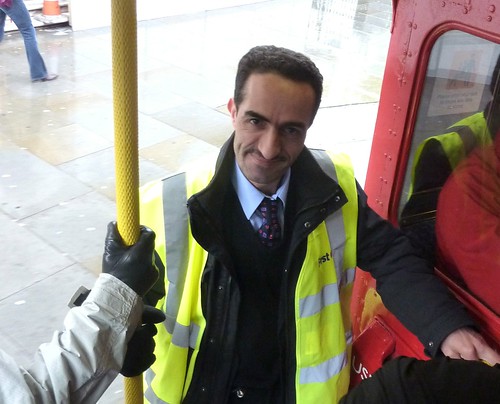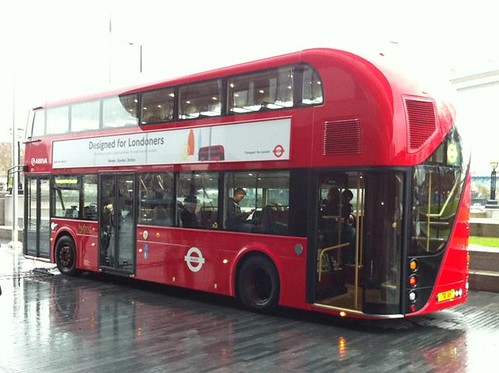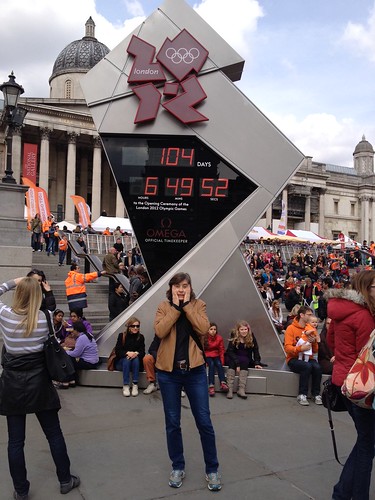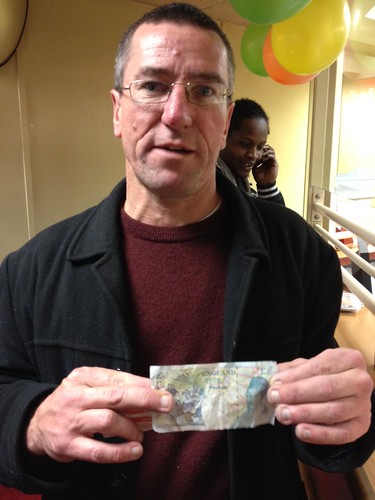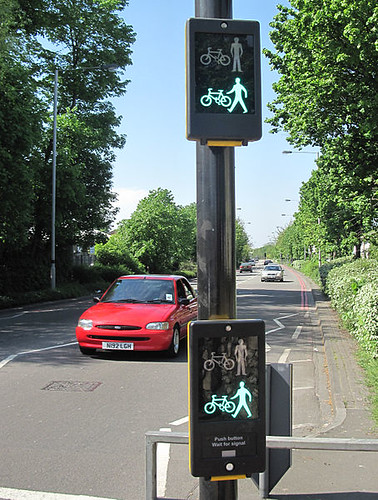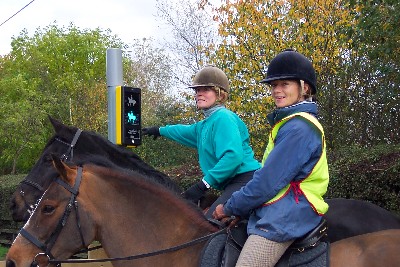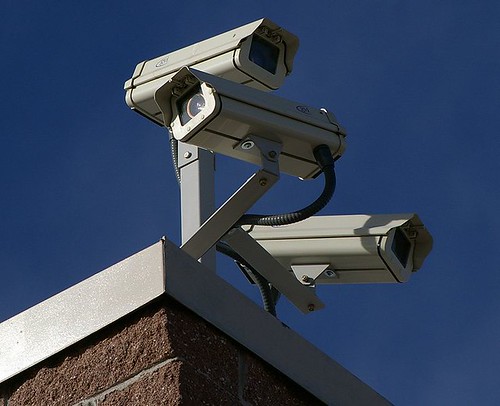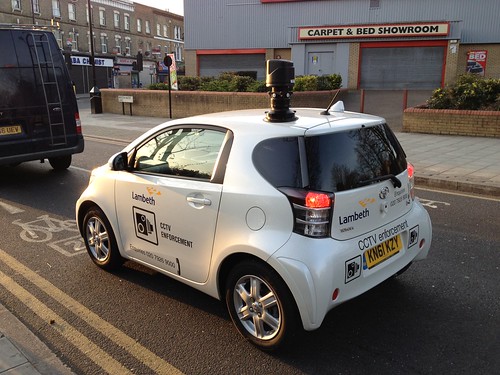The red double decker bus is one of the most beloved of London's icons. You'd have to be living under a rock to avoid them (And if you are, I hope you're not paying more than £500 per month, because despite the high cost of rent in London you should be able to find a nice rock in Zone 2 within walking distance of a tube station for somewhere in the neighbourhood of £450/month, not including utilities of course.)
When I lived in London in 1988 I used to take buses a lot and back then a red doubledecker bus was almost always a Routemaster (Pronunciation note: the "route" in "Routemaster" rhymes with "hoot" and "toot" not "out" and "about".) The Routemaster was first introduced to London's streets 1956, and is best known for its distinctive open rear deck. The driver is completely isolated from passengers in his own little cab, accessed from a separate little door on the traffic side of the bus. The design of the buses was quite innovative for the time, using lightweight aluminum* and aircraft building techniques honed in the Second World War. This meant that, despite being 3/4 of a ton lighter than previous models, the Routemaster carries 65 seated passengers vs. the 56 of previous models. Its light weight also made it more fuel efficient and therefore cheaper to run.
A classic Routemaster, showing the driver's compartment
Because the driver was isolated in his own cab, a conductor was needed to issue tickets to passengers and generally make sure the level of mayhem on the bus was kept to a minimum. Tickets were printed with a lovely little hand operated mechanical 'Gibson' ticket machine which hung around the conductor's neck and spat out paper tickets when the handle was cranked around. This all seems quite charming now, but I do recall that it was a bit of a pain needing change for the bus all the time. And the exceedingly open style made for a drafty, wet, cold ride sometimes.
However, all this was more than compensated for by the inestimable pleasure of being able to dash up to a departing Routemaster, grab the vertical bar and swing up onto the deck as the bus was pulling away. Better still, you could hop off the back of the bus any time you wanted: in between stops, in traffic, when the bus was moving, whatever. It was brilliant. Honestly, I can't think of anything that feels quite so perfectly LONDON-ish than hanging off the back of a Routemaster bus with the wind in your hair, waiting to hop off whenever the mood strikes you. Preferably with Big Ben tolling in the background and a pint of real ale in your near future.
Alighting from a Routemaster the boring way, with it stationary at its appointed bus stop.
Naturally, anything so excellent could not last. Despite the fact that the design was remarkably robust (Routemasters outlasted several replacement designs) the last of the famous breed were withdrawn from service in 2005. Several reasons were cited for this: newer designs without the open rear deck could be operated by the driver alone, carried more passengers, and allowed better disabled access. (Interestingly, the last route to operate with Routemasters was the 159 between Marble Arch and Streatham, which goes right past my house.)
However, the TFL also recognised that a complete lack of Routemasters on London's roads would be a tragedy to great to contemplate, possibly resulting in riots, or at least frequent tiresome moaning about the good old days when the post came twice a day and the pubs closed in the afternoon and you could get a proper cup of tea and a first class stamp cost 13p and blah blah blah..." They therefore contracted for the operation of "heritage routes" that would operate Routemasters in parallel with regular buses along short sections of two routes in central London. Thus it was that I set out on a rainy Saturday to catch the #9 from High Street Kensington to Trafalgar Square.
They don't issue tickets with the magic machine anymore, but the conductor did come up to the top deck to check my Oyster Card. It was an uneventful but really satisfying ride. The old Routemasters are such solid beasts. There's no plastic in sight, and the staircase that winds up the back of the bus is just how I remembered it, though I suppose I can see why people these days might be a bit wary. A tumble down those stairs would pitch you right out into traffic.
I had the top deck to myself for a bit so naturally I sat right at the front for the best view through the rain-speckled, foggy windows. I think it's almost a crime to sit on the bottom deck of a doubledecker bus. Especially on a sleepy Saturday when you're on your way to nowhere.
As the clever Italian man implied, the #9 passes alongside Hyde Park, taking in the Royal Albert Hall, the Albert Memorial, Hyde Park Corner, Marble Arch, and Green Park, before ending up at Trafalgar Square, where I alighted (alas, while the bus was stopped). The other Heritage Route (#15) starts at Trafalgar and passes St. Paul's en route to the Tower of London, also a highly worthwhile trip. As I was getting off at Trafalgar I took a picture of the conductor, who was a pleasant enough guy, but more accustomed to taking photos of other people with his bus, than having his photo taken.
Interestingly, the death of the Routemaster has a bearing on a very current political debate here in London. There's a mayoral election in London next week, on May 3rd. I'll actually get to vote in the election, which I'm kind of keen about. The two main candidates are the current incumbent, Boris Johnson (Conservative Party), and the previous mayor, Ken Livingstone (Labour Party, known colloquially as "Red Ken"). Ken Livingstone was the one who started phasing out of the Routemaster in 2004 for all the reasons I've already mentioned. He's also the one who introduced the single-decker articulated "bendy bus" to London's streets.
Alternatively, Boris Johnson is partly known for his election promise to introduce a new, modern version of the Routemaster to London's streets. These new buses do have the open rear deck and the distinctive rear staircase, but the rear opening can be closed off during slow periods, meaning that the bus doesn't require a conductor at those times. The bus also has doors at the middle and the front, and an additional staircase, which frankly seems excessive to me. However, I like the swoopy sort of design. Three of the New Routemasters are currently in service on the #38 route from Victoria but sadly they aren't used on evenings and weekends, so I couldn't try one out on my Routemaster Day.
And there you have it, a little look at one of London's icons. I'd definitely recommend a ride on an old Routemaster the next time you're in town. It's a fun, cheap treat and a bit of a time warp. Just make sure to get off while the bus is moving for maximum effect. (Note from the GSWPL Legal Department: Go Stay Work Play Live bears no responsibility for any injury of death resulting from following the above recommendation.) (Note from the GSWPL Fun Department: Do it do it do it!) (Note from the GSWPL Peer Pressure Department: All the cool kids are doing it. Come on, you know you wanna...) (Note from the GSWPL Extraneous Notes Department: Sorry about this, sometimes I just get carried away.)
In other vehicularly-related news - I passed my driving test on Wednesday, which is an immense relief. Though I was very very nervous, I did have the lovely Mohammed with me this time, so instead of a harrowing two-hour last-minute lesson-cum-Spanish-Inquisition before the actual test, I had a very empowering, confidence building spin around the Hither Green area with Mohammed, and still had time for a sandwich and a coffee before the test. And when it was all over, the examiner actually complimented me on my driving. Yay for me!
In other Pam-related news, we passed the 100-days-to-go-to-the-Olympic-Opening-Ceremony landmark a short time ago, which everyone I speak to has been mentioning incessantly, which is simply rubbing salt into the wound, thank you very much, because I eat, sleep and breathe that schedule. The workload continues to increase, and evenings and weekends off are fast becoming a rarity. This is not unexpected, but I've come to realise in the last few weeks that I need to start cutting out all extraneous activities, which basically means everything except work, grocery-buying, laundry and the occasional moment sitting staring at a wall doing NOTHING. Running, socialising, hashing, and, err... blogging... they've all got to happen only when I've genuinely got the time and the brain energy and the desire simultaneously. So while I'll continue to write when the stars align, please don't be crushed if new blogs appear less and less frequently. Just know that I'm engaged in A Great Work, and please tune in on July 27th.
* Ok, time to talk about The Great Aluminum / Aluminium Debate. In North America, it's aluminum (Ah-LOO-min-um). Here, it's aluminium - note the extra syllable (Ah-loo-MIN-ee-um). This catches me out all the time, but is one place where I've kind of dug in my heels on the basis that the guy who first identified the element (Humphry Davy) settled on the name "aluminum" in 1812.
The #9, arriving at exactly the right moment to pick me up, which is lucky indeed since it was indeed a very rainy day.
Taken from the top of the stairs of a moving Routemaster
The top deck, blissfully empty. Because it's a popular attraction, the Routemaster on the #9 route attracts a lot of tourists. It wasn't long before I was joined by a large crowd on the upper deck, including a nice enough Italian couple, one half of which conducted what sounded like a pretty credible running commentary that went like this: "Italian Italian Italian Italian Italian Buckingham Palace Italian Italian Italian Royal Albert Hall Italian Italian Italian Italian Italian Italian Italian Kensington Palace Italian Italian Italian Harrod's Italian Fayed Italian Italian Italian Picadilly Circus Italian Italian Italian" etc...
Interestingly, the death of the Routemaster has a bearing on a very current political debate here in London. There's a mayoral election in London next week, on May 3rd. I'll actually get to vote in the election, which I'm kind of keen about. The two main candidates are the current incumbent, Boris Johnson (Conservative Party), and the previous mayor, Ken Livingstone (Labour Party, known colloquially as "Red Ken"). Ken Livingstone was the one who started phasing out of the Routemaster in 2004 for all the reasons I've already mentioned. He's also the one who introduced the single-decker articulated "bendy bus" to London's streets.
Alternatively, Boris Johnson is partly known for his election promise to introduce a new, modern version of the Routemaster to London's streets. These new buses do have the open rear deck and the distinctive rear staircase, but the rear opening can be closed off during slow periods, meaning that the bus doesn't require a conductor at those times. The bus also has doors at the middle and the front, and an additional staircase, which frankly seems excessive to me. However, I like the swoopy sort of design. Three of the New Routemasters are currently in service on the #38 route from Victoria but sadly they aren't used on evenings and weekends, so I couldn't try one out on my Routemaster Day.
The new Routemaster. Not bad. Ironically, when Johnson was elected in 2008, he started scrapping Ken's bendy buses. Now Ken is threatening to halt the roll-out of the new Routemaster if he's elected on Thursday. It's Busgate, I tell ya.
And there you have it, a little look at one of London's icons. I'd definitely recommend a ride on an old Routemaster the next time you're in town. It's a fun, cheap treat and a bit of a time warp. Just make sure to get off while the bus is moving for maximum effect. (Note from the GSWPL Legal Department: Go Stay Work Play Live bears no responsibility for any injury of death resulting from following the above recommendation.) (Note from the GSWPL Fun Department: Do it do it do it!) (Note from the GSWPL Peer Pressure Department: All the cool kids are doing it. Come on, you know you wanna...) (Note from the GSWPL Extraneous Notes Department: Sorry about this, sometimes I just get carried away.)
In other vehicularly-related news - I passed my driving test on Wednesday, which is an immense relief. Though I was very very nervous, I did have the lovely Mohammed with me this time, so instead of a harrowing two-hour last-minute lesson-cum-Spanish-Inquisition before the actual test, I had a very empowering, confidence building spin around the Hither Green area with Mohammed, and still had time for a sandwich and a coffee before the test. And when it was all over, the examiner actually complimented me on my driving. Yay for me!
In other Pam-related news, we passed the 100-days-to-go-to-the-Olympic-Opening-Ceremony landmark a short time ago, which everyone I speak to has been mentioning incessantly, which is simply rubbing salt into the wound, thank you very much, because I eat, sleep and breathe that schedule. The workload continues to increase, and evenings and weekends off are fast becoming a rarity. This is not unexpected, but I've come to realise in the last few weeks that I need to start cutting out all extraneous activities, which basically means everything except work, grocery-buying, laundry and the occasional moment sitting staring at a wall doing NOTHING. Running, socialising, hashing, and, err... blogging... they've all got to happen only when I've genuinely got the time and the brain energy and the desire simultaneously. So while I'll continue to write when the stars align, please don't be crushed if new blogs appear less and less frequently. Just know that I'm engaged in A Great Work, and please tune in on July 27th.
* Ok, time to talk about The Great Aluminum / Aluminium Debate. In North America, it's aluminum (Ah-LOO-min-um). Here, it's aluminium - note the extra syllable (Ah-loo-MIN-ee-um). This catches me out all the time, but is one place where I've kind of dug in my heels on the basis that the guy who first identified the element (Humphry Davy) settled on the name "aluminum" in 1812.
But the same year, an anonymous contributor to the Quarterly Review, a British political-literary journal, in a review of Davy's book, objected to aluminum and proposed the name aluminium, "for so we shall take the liberty of writing the word, in preference to aluminum, which has a less classical sound." (Wikipedia)
What a poncey git.



